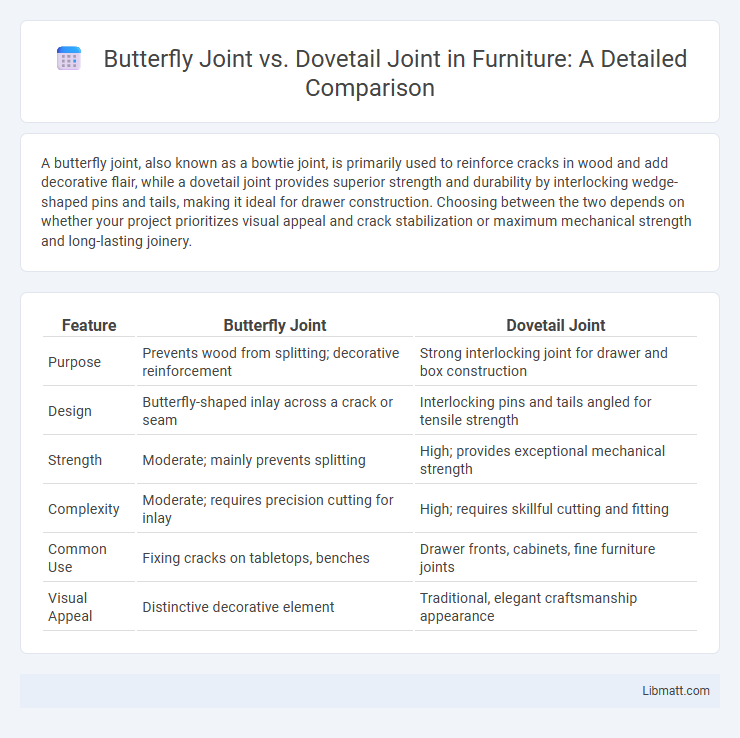A butterfly joint, also known as a bowtie joint, is primarily used to reinforce cracks in wood and add decorative flair, while a dovetail joint provides superior strength and durability by interlocking wedge-shaped pins and tails, making it ideal for drawer construction. Choosing between the two depends on whether your project prioritizes visual appeal and crack stabilization or maximum mechanical strength and long-lasting joinery.
Table of Comparison
| Feature | Butterfly Joint | Dovetail Joint |
|---|---|---|
| Purpose | Prevents wood from splitting; decorative reinforcement | Strong interlocking joint for drawer and box construction |
| Design | Butterfly-shaped inlay across a crack or seam | Interlocking pins and tails angled for tensile strength |
| Strength | Moderate; mainly prevents splitting | High; provides exceptional mechanical strength |
| Complexity | Moderate; requires precision cutting for inlay | High; requires skillful cutting and fitting |
| Common Use | Fixing cracks on tabletops, benches | Drawer fronts, cabinets, fine furniture joints |
| Visual Appeal | Distinctive decorative element | Traditional, elegant craftsmanship appearance |
Introduction to Woodworking Joints
Butterfly joints and dovetail joints are essential woodworking techniques that offer both structural strength and aesthetic appeal. Butterfly joints, often used to reinforce cracks or join two pieces of wood edge-to-edge, provide a visible decorative element while preventing separation. Dovetail joints, renowned for their interlocking design, deliver superior durability in cabinetry and drawer construction, ensuring your projects maintain longevity and precision.
What is a Butterfly Joint?
A Butterfly Joint is a woodworking technique used to reinforce cracks or join two pieces of wood with a butterfly-shaped inlay, usually made from contrasting hardwood. This joint not only strengthens but also serves as a decorative element, preventing further splitting or separating of the wood. Your woodworking projects can benefit from the Butterfly Joint's unique blend of function and aesthetic appeal, especially in furniture and fine woodworking.
What is a Dovetail Joint?
A dovetail joint is a woodworking technique characterized by interlocking trapezoidal shapes that create strong mechanical resistance, often used in drawer construction and cabinet making. This joint offers excellent tensile strength, preventing the pieces from pulling apart under stress, which makes it highly durable for furniture and cabinetry. Understanding a dovetail joint can enhance your craftsmanship by providing long-lasting and aesthetically pleasing connections without the need for nails or screws.
Historical Use and Origins
Butterfly joints, originating in Asian woodworking traditions, were historically used to stabilize cracks and add decorative reinforcement to furniture and wooden objects. Dovetail joints have roots in ancient Egyptian and Chinese craftsmanship, celebrated for their interlocking strength and commonly employed in drawer and box construction. Your choice between these joints can reflect a blend of aesthetic heritage and functional durability grounded in centuries-old woodworking techniques.
Structural Strength Comparison
Butterfly joints and dovetail joints both enhance structural strength, but dovetail joints provide superior resistance to tensile and shear forces due to their interlocking design, making them ideal for drawer construction and heavy load-bearing applications. Butterfly joints primarily serve as decorative reinforcements to stabilize cracks or join flat pieces of wood, offering moderate tensile strength but less mechanical interlock than dovetails. In woodworking projects demanding maximum joint durability and longevity, dovetail joints are preferred for their enhanced load distribution and resistance to pulling apart.
Aesthetic Appeal and Design
Butterfly joints showcase a striking, wing-shaped inlay that enhances woodwork with a distinct decorative flair and visible craftsmanship, often used as both a functional and artistic accent. Dovetail joints, characterized by interlocking trapezoidal pins and tails, provide a traditional, timeless aesthetic that emphasizes strength and meticulous joinery, commonly found in high-quality cabinetry and furniture. Both joints offer unique visual appeal, with butterfly joints accentuating natural grain patterns and dovetail joints highlighting precision and structural integrity.
Ease of Construction
Butterfly joints offer relatively easy construction, requiring basic tools and straightforward cutting techniques, making them suitable for beginners and quick repairs. Dovetail joints demand precise cutting and advanced skills, often needing jigs or templates to achieve their intricate interlocking design. Your choice depends on the desired strength and aesthetic, balanced against your woodworking experience and available tools.
Typical Applications in Furniture
Butterfly joints are commonly used as decorative reinforcement in tabletops and live-edge wood slabs, preventing cracks from widening while adding aesthetic appeal. Dovetail joints are predominantly found in drawers, cabinets, and box constructions, prized for their exceptional strength and resistance to pulling forces. Both joints enhance furniture durability but serve distinctly different structural and visual purposes.
Durability and Longevity
Butterfly joints provide strong reinforcement for cracks and prevent wood pieces from splitting, enhancing durability in furniture and cabinetry. Dovetail joints offer exceptional interlocking strength through their angled pins and tails, ensuring long-lasting stability in drawer construction and box making. Both joints contribute to longevity, but dovetail joints are generally preferred for load-bearing applications due to their superior resistance to pulling forces.
Choosing the Right Joint for Your Project
Selecting between a butterfly joint and a dovetail joint depends on the project's structural needs and aesthetic preferences. Butterfly joints excel in reinforcing cracks and adding visual interest to tabletops or furniture with visible splits, while dovetail joints provide superior strength and durability for drawers, cabinets, and box construction. Understanding the functional demands and design goals ensures the right joint enhances both the integrity and appearance of your woodworking project.
Butterfly Joint vs Dovetail Joint Infographic

 libmatt.com
libmatt.com